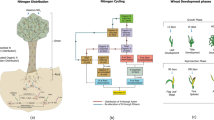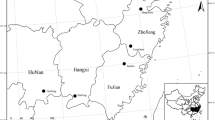Summary
The hypothesis was tested that faster growth of nitrophilic plants at high nitrogen (N) nutrition is counterbalanced by faster growth of non-nitrophilic plants at low N-nutrition. Ten annual plant species were used which originated from habitats of different N-availability. The species' preference for N was quantified by the “N-number” of Ellenberg (1979), a relative measure of nitrophily. The plants were cultivated in a growth cabinet at five levels of ammonium-nitrate supply. At low N-supply, the relative growth rate (RGR) was independent of nitrophily. At high N-supply, RGR tended to be higher in nitrophilic than in non-nitrophilic species. However, the response of RGR to N-supply was strongly and positively correlated with the nitrophily of species. Increasing N-supply enhanced partitioning to leaf weight per total biomass (LWR) and increased plant leaf area per total biomass (LAR). Specific leaf weight (SLW) and LWR were both higher in non-nitrophilic than in nitrophilic species at all levels of N-nutrition. NAR (growth per leaf area or net assimilation rate) increased with nitrophily only under conditions of high N-supply. RGR correlated positively with LAR, irrespective of N-nutrition. Under conditions of high N-supply RGR correlated with SLW negatively and with NAR positively.
Similar content being viewed by others
References
Berendse F, Elberse WT (1990) Competition and nutrient losses from the plant. In: Lambers H, Cambridge ML, Konings H, Pons TL (eds) Causes and Consequences of Variation in Growth Rate and Productivity of Higher Plants, SPB Academic Publishing, The Hague, pp 257–267
Bradshaw AD, Chadwick MJ, Jowett D, Snaydon RW (1964) Experimental investigations into the mineral nutrition of several grass species. IV. Nitrogen level. J Ecology 52:665–676
Brower R (1962) Nutritive influences on the distribution of dry matter in the plant. Netherlands J Agri Science 10:399–408
Chapin FS III (1980) The mineral nutrition of wild plants. Annu Rev Ecol Syst 11:233–260
Chapin FS III, Schulze E-D, Mooney HA (1990) The ecology and economics of storage in plants. Annu Rev Ecol Syst 21:423–447
Clarkson (1985) Factors affecting mineral nutrient acquisition by plants. Ann Rev Plant Phys 36:77–115
Dijkstra P (1990) Cause and effect of differences in specific leaf area. In: Lambers H, Cambridge ML, Konings H, Pons TL (eds) Causes and Consequences of Variation in Growth Rate and Productivity of Higher Plants, SPB Academic Publishing, The Hague, pp 125–140
Ellenberg H (1979) Zeigerwerte der Gefäßpflanzen Mitteleuropas. Scripta Geobotanica 9
Epstein E (1972) Mineral Nutrition of Plants. Principles and Perspectives. John Wiley and Sons, New York
Grime JP, Hunt R (1975) Relative growth-rate: its range and adaptive significance in a local flora. J Ecol 63:393–422
Hunt R (1982) Plant growth curves. The functional approach to growth analysis. Edward Arnold, London
Hunt R, Parsons IT (1974) A computer program for deriving growth-functions in plant growth-analysis. J Appl Ecol 11:297–307
Kuiper D, Kuiper PJC (1979) Comparison of Plantago species from nutrient-rich and nutrient-poor conditions: growth response, ATPases and lipids of the roots, as affected by the level of mineral nutrition. Physiol Plant 45:489–491
Lambers H, Dijkstra P (1987) A physiological analysis of genotype variation in relative growth rate: Can growth rate confer ecological advantage? In: van Andel J, Bakker JP, Snaydon RW (eds) Disturbance in Grasslands, Junk, Dordrecht, pp 237–252
Lambers H, Cambridge ML, Konings H, Pons TL (1990) Causes and Consequences of Variation in Growth Rate and Productivity of Higher Plants, SPB Academic Publishing, The Hague
McDonald AJS (1990) Phenotypic variation in growth rate as affected by N-supply: its effects on NAR, LWR and SLA. In: Lambers H, Cambridge ML, Konings H, Pons TL (eds) Causes and Consequences of Variation in Growth Rate and Productivity of Higher Plants, SPB Academic Publishing, The Hague, pp 35–44
Medina E (1971) Effect of nitrogen supply and light intensity during growth on the photosynthetic capacity and carboxydismutase activity of leaves of Atriplex patula ssp. hastata. Carnegie Inst Wash Year Book 70:551–559
Monsi M (1960) Dry-matter production in plants. I. Schemata of dry-matter reproduction. Bot Mag 73:81–90
Orians GH, Solbrig OT (1977) A cost-income model of leaves and roots with special reference to arid and semiarid areas. Am Nat 111:1086–1095
Parsons RF (1968) The significance of growth-rate comparisons for plant ecology. Am Nat 102:595–597
Poorter H (1990) Interspecific variation in relative growth rate: On ecological causes and physiological consequences. In: Lambers H, Cambridge ML, Konings H, Pons TL (eds) Causes and Consequences of Variation in Growth Rate and Productivity of Higher Plants, SPB Academic Publishing, The Hague, pp 159–174
Poorter H, Remkes C (1990) Leaf area ratio and net assimilation rate of 24 wild species differing in relative growth rate. Oecologia 83:553–559
Potter JR, Jones JW (1977) Leaf area partitioning as an important factor in growth. Plant Physiol 59:10–14
Roush ML, Radosevich SR (1985) Relationships between growth and competitiveness of four annual weeds. J Appl Ecol 22:895–905
Sage RF, Pearcy RW (1987) The nitrogen use efficiency of C3 and C4 plants. I. Leaf nitrogen, growth, and biomass partitioning in Chenopodium album (L.) and Amaranthus retroflexus (L.). Plant Physiol 84:954–958
Schulze E-D, Chapin FS III (1987) Plant specialization to environments of different resource availability. In: Potentials and limitations of ecosystem analysis, E.-D. Schulze, H. Zwölfer (eds), Ecological Studies Vol. 61, Springer Verlag, Berlin Heidelberg New York, pp 120–148
Shipley B, Keddy PA (1988) The relationship between relative growth rate and sensitivity to nutrient stress in twentyeight species of emergent macrophytes. J Ecology 76:1101–1110
Stulen I, Lanting L, Lambers H, Posthumus FS, Van de Dijk SJ, Hofstra R (1981) Nitrogen metabolism of Plantago major ssp. major as dependent on the supply of mineral nutrients. Physiol Plant 52:108–114
Tilman D (1982) Resource Competition and Community Structure. Princeton University Press, Princeton
Tilman D (1986) Resources, competition and the dynamics of plant communities. In: Crawley MJ (ed) Plant Ecology, Blackwell Scientific Publications, Oxford, pp 51–75
Walter H (1963) Über die Stickstoffansprüche (die Nitrophilie) der Ruderalpflanzen. Mitt flor-soz Arb.gem N.F. 10:56–69
Author information
Authors and Affiliations
Rights and permissions
About this article
Cite this article
Fichtner, K., Schulze, E.D. The effect of nitrogen nutrition on growth and biomass partitioning of annual plants originating from habitats of different nitrogen availability. Oecologia 92, 236–241 (1992). https://doi.org/10.1007/BF00317370
Received:
Accepted:
Issue Date:
DOI: https://doi.org/10.1007/BF00317370




